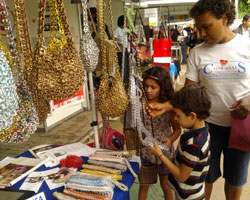The Green Economy in the Era of Occupy
 Hannah Miller
Hannah MillerWorld leaders at the Earth Summit in Rio were supposed to chart a way forward for the green economy. But can they even agree on what it means?
What exactly is the “green economy”? At the Earth Summit in Rio, it depends on who you talk to.
“As an Indian, as someone from the global South, the ‘green economy’ means a way to market Western technology to the developing world. It is something for people who already have things; it is not for me,” says Abhishek Thakore, 30, a nonprofit leader from Bombay, on Tuesday. “But as a youth, it is innovation, a reduction in consumption, necessary for survival. It is the way I want the world to be.”
The theme of the United Nations Rio + 20 Earth Summit, “The Green Economy,” provoked complicated debates among U.N. delegations, protestors and civil society. Although many of the policy proposals themselves were universally embraced—organic farming, intercropping, soil management, support for public transit—the phrase itself brings ominous overtones in the age of Occupy, and in a world with vast disparities of wealth and resources.
Earlier this year, the United Nations Environment Program outlined what it meant in its 626-page report “Towards a Green Economy: Pathways to Sustainable Development and Poverty Eradication,” including some familiar recommendations:
· Transition to organic agriculture, which is more profitable, and more labor intensive (thereby creating jobs).
· Fishery reform and management.
· Water efficiency infrastructure (which saves money that could be used elsewhere) and increasing access to water and sanitation, which is critical for poor countries to develop their economies.
· Forest protection through payments for conservation, reduced impact logging and certification of wood.
· Renewable energy: growing apace, with a $243 billion worldwide investment in 2010; it employs two to four times the number of people as fossil fuels do per megawatt hour.
· Closed-cycle manufacturing (remanufacturing, reconditioning and recycling); these are locally labor intensive, without a large capital investment.
· Local, professionalized waste treatment, which improves local health.
· Retrofitting buildings for efficiency in the developed world, and greening new buildings in the developing world.
· Green transit infrastructure and sustainable tourism jobs.
Despite these guidelines and over 7,000 pages of input from NGOs, businesses, scientists, women, youth and more, the bloodless final document was released on Wednesday, committing the U.N. practically to actually achieving almost none of these ideas. As was pointed out, The Future We Want doesn’t contain the phrase “green jobs”.
“We are very far in this text from a new paradigm; this is not a vision,” said former Irish president Mary Robinson at an event on Thursday in global inequality. “We do not have leadership in Rio and we have to stop the rot. We need people to take it home and say, if you don’t listen to us, you’re gone!” she said, to applause and cheers.
Negotiators and members of the process blamed a lack of international trust for the inability to forge a consensus, including a history of U.N. anti-poverty programs that had been terrible for the environment: the Green Revolution of the 1960s, which industrialized agriculture, or the history of hydroelectric power. Negotiators remembered the climate talks, when some developed countries flat-out refused to curb consumption.
But the most controversial idea discussed in Rio was the “natural capital,” the idea that economic systems should put a dollar value on natural resources.
Proponents have long argued that putting a dollar price on ecosystems, trees, water, etc., will encourage careful resource use—including the undeniable bonus of making renewable energy finally financially competitive with fossil fuels. They point to the success of Costa Rica’s Payments for Environmental Services (PES) system, in which forest owners are compensated for the biodiversity they protect by not cutting down trees, and for the amount of carbon sequestered.
Opponents fear that commodifying nature will lead to the creation of some financial services chimeras. Rainforest derivatives? Genetic diversity credit swaps?
“The risk of confusion between value and price is considerable,” writes Friends of the Earth (FoE) France. “Nature has an immense value for its own sake, but trying to give it a price will almost inevitably lead to the creation of new markets with clearly identified pitfalls.”
Some of those pitfalls identified by FoE are increased market prices for endangered species, (which could lead to increased poaching), and upsetting the balance of ecosystems by disproportionally valuing certain species.
Although natural capital may not have been a part of the final agreement, Vice-Chair Sam Di Piazza says that banking and financial institutions are already assuming it is on its way. The carbon markets, the first attempt at measuring humankind’s impact, will forecast some of the implications of this—economic, political, cultural and philosophical.
Meanwhile, at the People’s Summit at Rio, the Green Business Entrepreneurs tent was filled with small Brazilian eco-companies and packed with attendees. “It’s easy to dismiss the negotiations out of hand,” says Chris Garrard, a composer from Oxford and part of the youth delegation. “But when I think about the green economy, I think about it as companies being cooperative and innovative. To me, the green economy means power is more distributed. It’s capitalist, just not the same way.”

